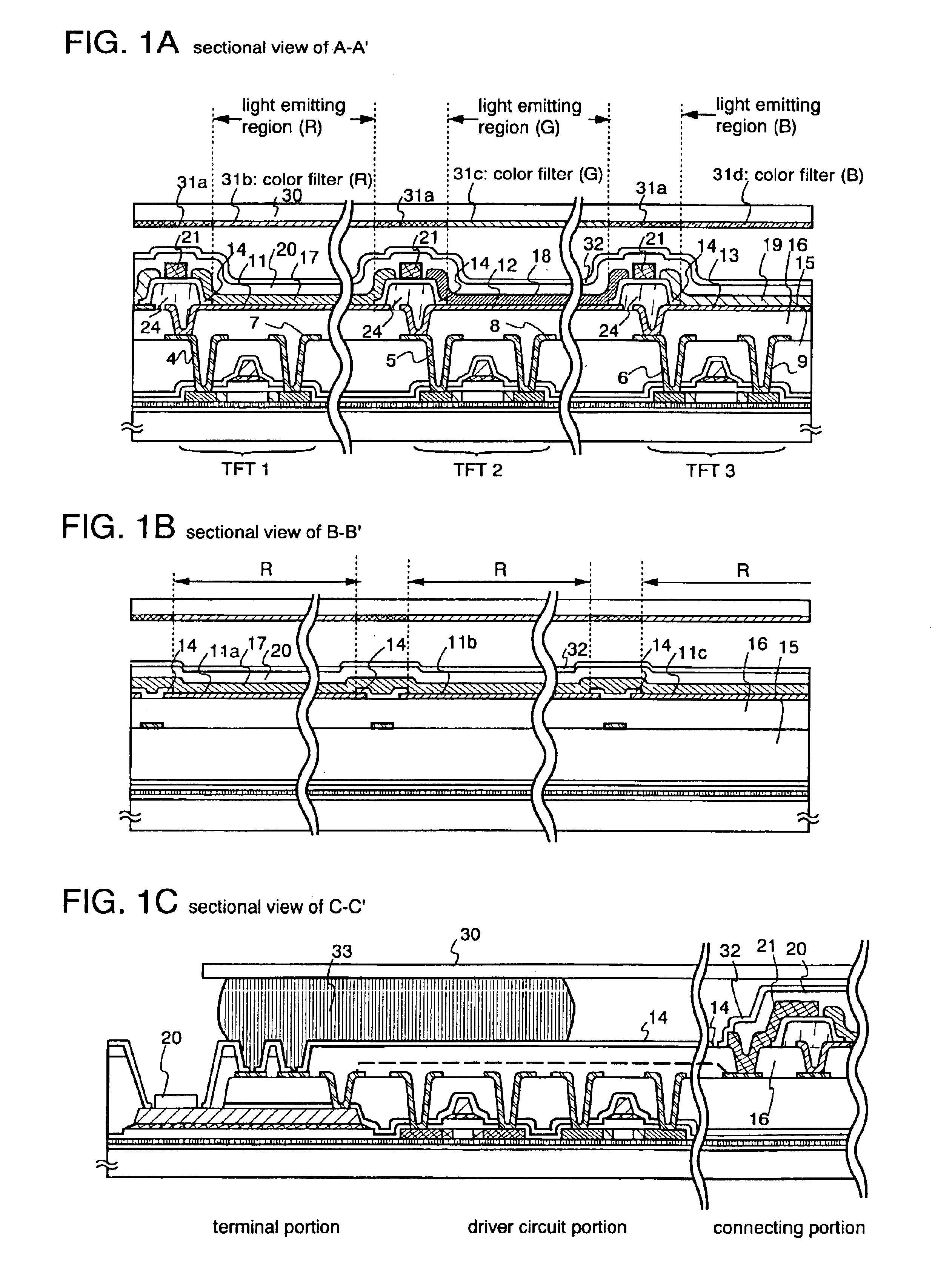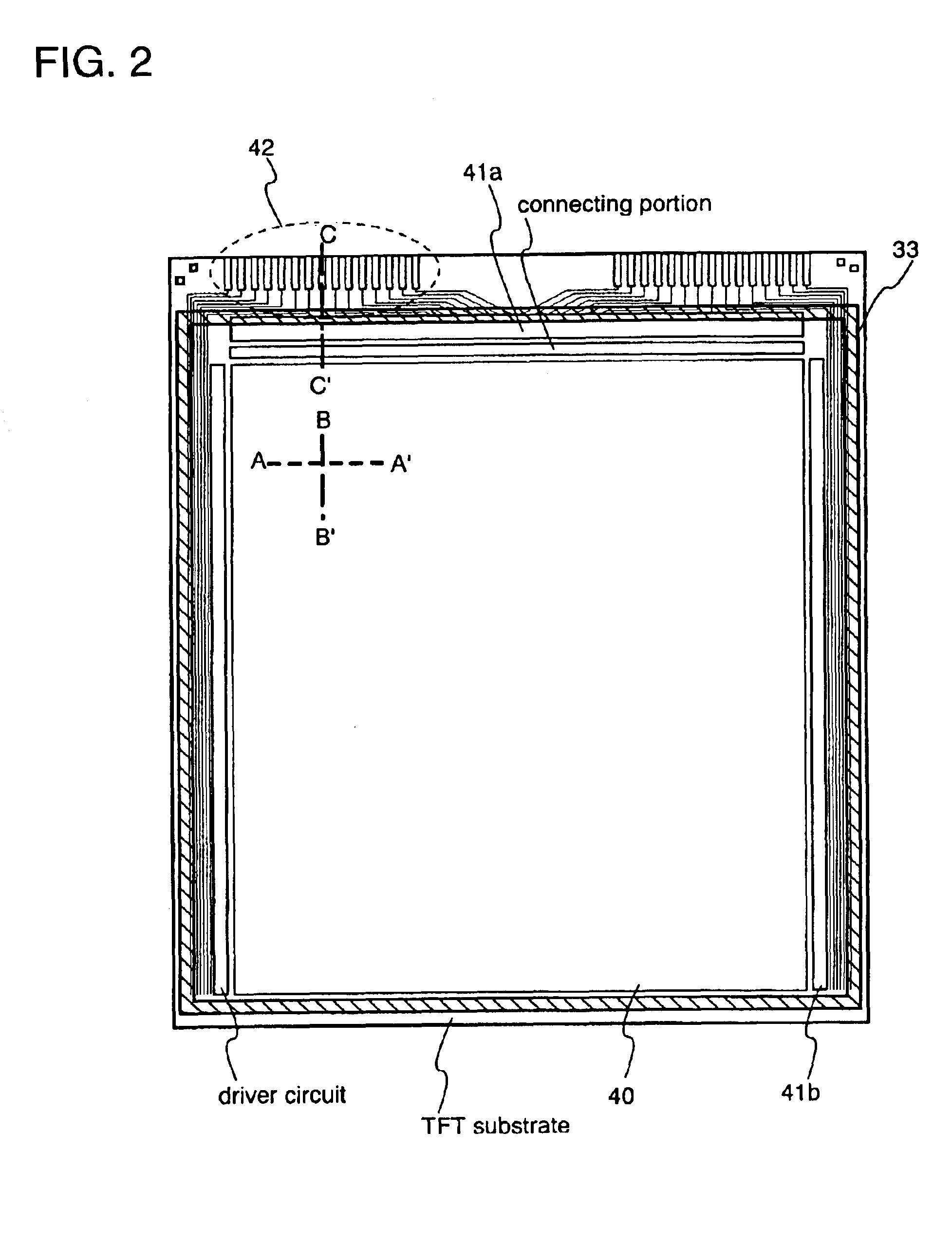Light emitting device and method of manufacturing the same
a technology of light emitting devices and manufacturing methods, applied in the field of semiconductor devices, can solve the problems of non-uniform surface potential distribution and higher film resistance of transparent electrodes, and achieve the effect of efficient diffusion of hydrogen and increased light emitting devices
- Summary
- Abstract
- Description
- Claims
- Application Information
AI Technical Summary
Benefits of technology
Problems solved by technology
Method used
Image
Examples
embodiment mode 1
[Embodiment Mode 1]
FIG. 2 is a top view of an EL module. In the figure, over a substrate (also referred to as TFT substrate) where a number of TFTs are provided, there are formed a pixel portion 40 used for display, driver circuits 41a and 41b for driving pixels of the pixel portion, a connecting portion for connecting an electrode formed on an EL layer and a lead wiring, and a terminal portion 42 to which an FPC is attached for connecting an external circuit therewith. Also, a substrate for sealing an EL element and a sealing member 33 are used to attain a sealed state. FIG. 1A is a sectional view taken along the dashed line A-A' of FIG. 2.
The pixels are arranged regularly in the direction of the dashed line A-A'. Here, an example of the pixels arranged in the order of R, G, and B in an X direction will be shown.
In FIG. 1A, a light emitting region (R) indicates a region for emitting a red light; a light emitting region (G), a region for emitting a green light; and a light emitting ...
embodiment mode 2
[Embodiment Mode 2]
Here, the film containing hydrogen and the protective film will be described with reference to FIGS. 4A and 4B.
FIG. 4A is a schematic diagram showing an example of a laminate structure of the EL element. In FIG. 4A, reference numeral 200 denotes a cathode (or an anode); 201, an EL layer; 202, an anode (or a cathode); 203, a DLC film containing hydrogen; and 204, a protective film. When the emitted light is caused to pass through the anode 202, a conductive film having a light-transmissive property (ITO, ZnO, etc.) is preferably used as the anode 202. Also, as the cathode 200, a metal film (an alloy film of MgAg, MgIn, AlLi, etc. or a film formed by coevaporation of aluminum and an element belonging to Group 1 or 2 in the periodic table) or a laminate thereof is preferably used.
The protective film 204 may be made of an insulating film mainly containing silicon nitride or silicon oxynitride which is obtained by a sputtering method (DC system or RF system). The silic...
embodiment mode 3
[Embodiment Mode 3]
Here, FIGS. 6A to 6C show an example of a structure partially different from FIGS. 1A to 1C. In this example, among a number of pixels arranged regularly in the pixel portion, pixels in a 3.times.3 matrix are used by way of example and the present invention will be described below. Note that, in a sectional structure, TFTs of FIGS. 6A to 6C are substantially the same as those of FIGS. 1A to 1C and thus components identical to those of FIGS. 1A to 1C are denoted by identical reference numerals for simplicity.
FIG. 6A is a sectional view taken along the alternate long and short dash line A-A' of FIG. 5A. A light emitting region 50R indicates a red light emitting region; a light emitting region 50G, a green light emitting region; and a light emitting region 50B, a blue light emitting region. These light emitting regions of three colors realize a light emitting display device capable of full color display.
As shown in FIG. 6A, this embodiment mode employs an example in ...
PUM
 Login to View More
Login to View More Abstract
Description
Claims
Application Information
 Login to View More
Login to View More - R&D
- Intellectual Property
- Life Sciences
- Materials
- Tech Scout
- Unparalleled Data Quality
- Higher Quality Content
- 60% Fewer Hallucinations
Browse by: Latest US Patents, China's latest patents, Technical Efficacy Thesaurus, Application Domain, Technology Topic, Popular Technical Reports.
© 2025 PatSnap. All rights reserved.Legal|Privacy policy|Modern Slavery Act Transparency Statement|Sitemap|About US| Contact US: help@patsnap.com



